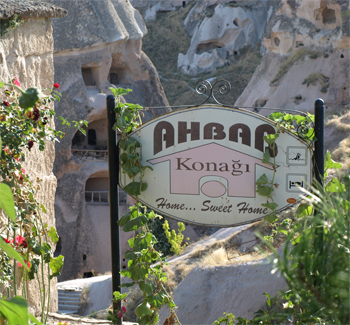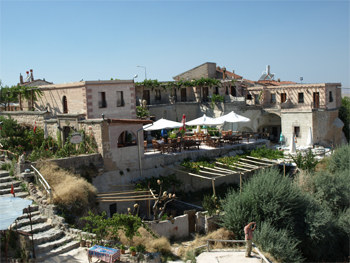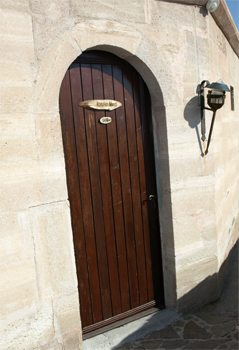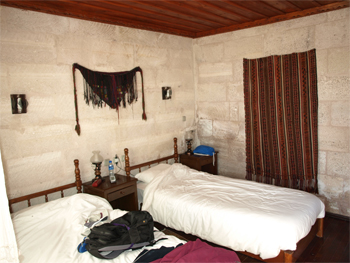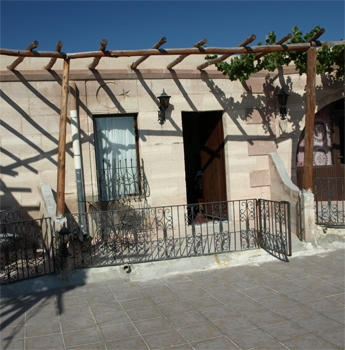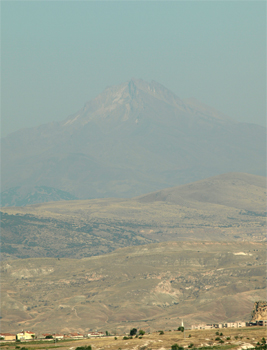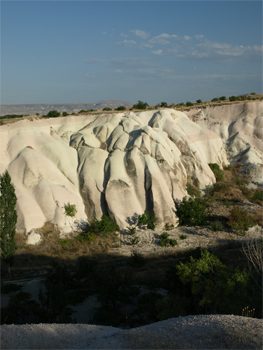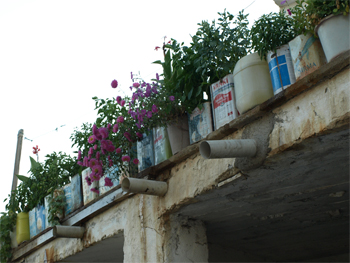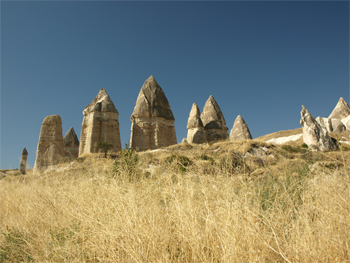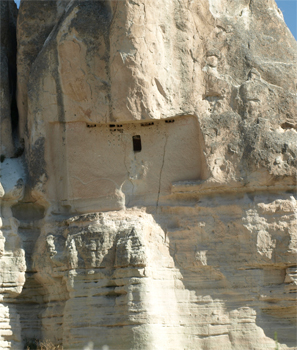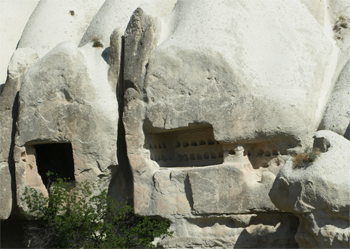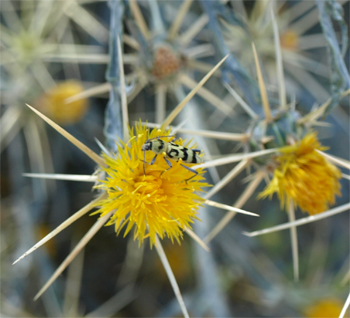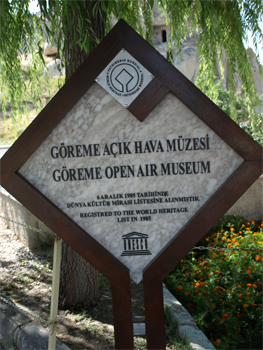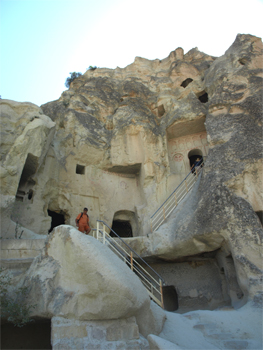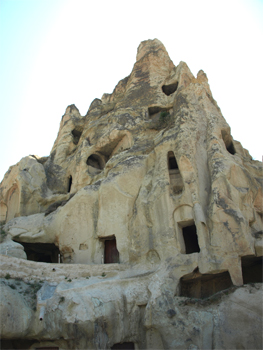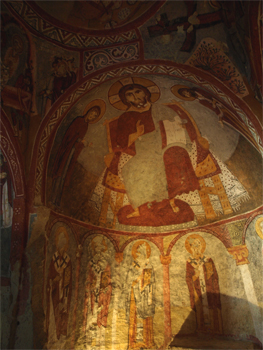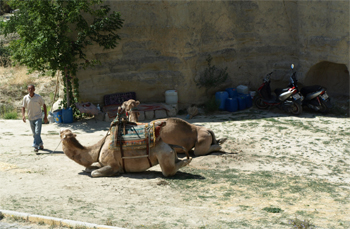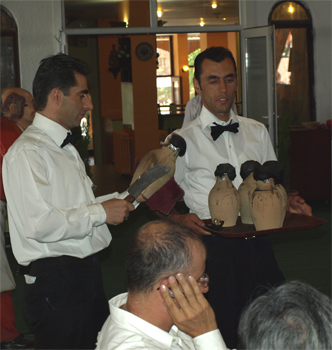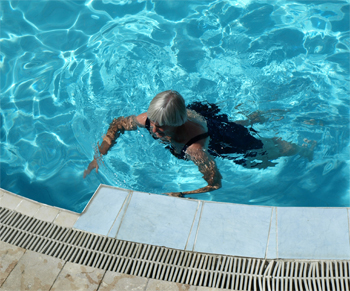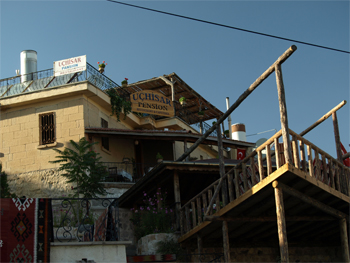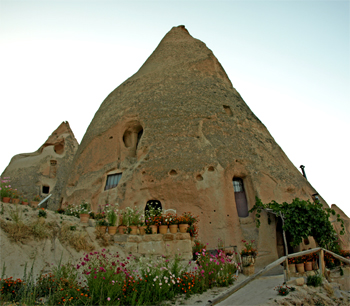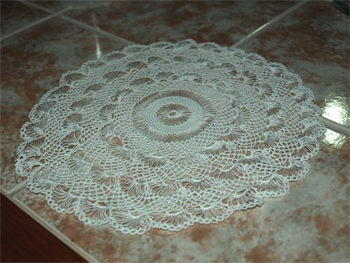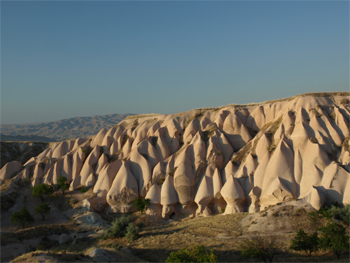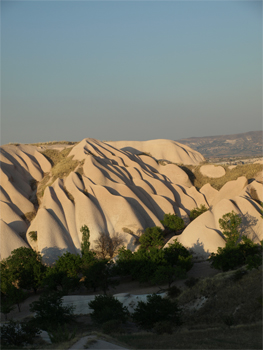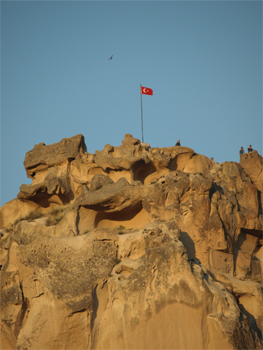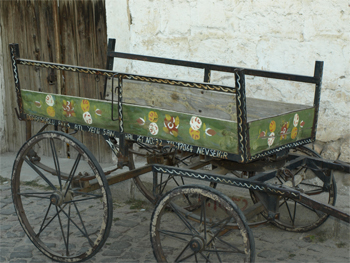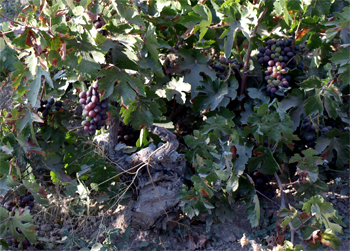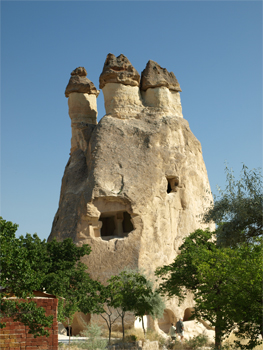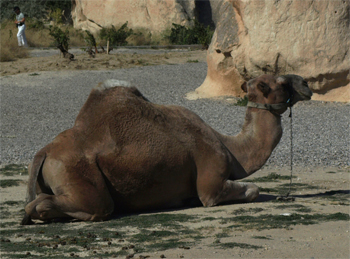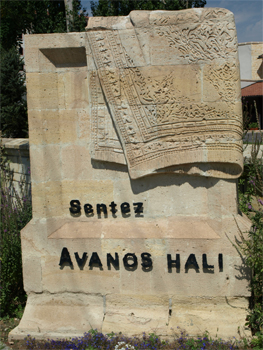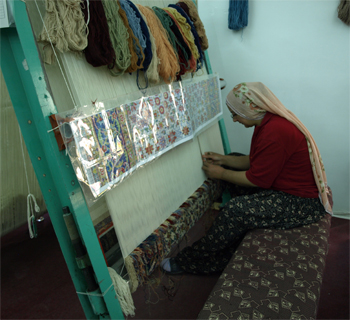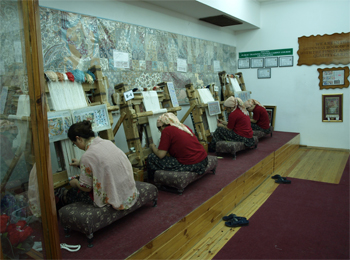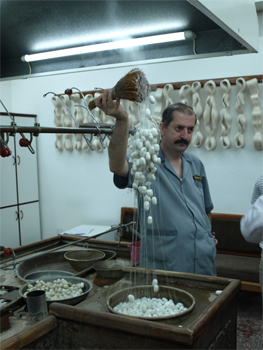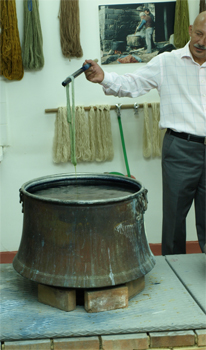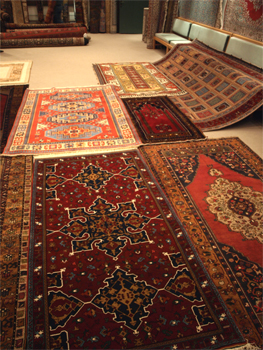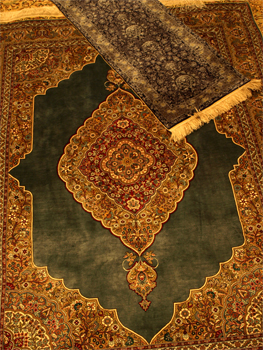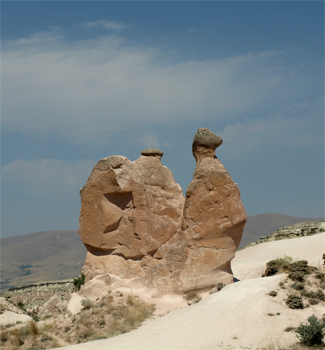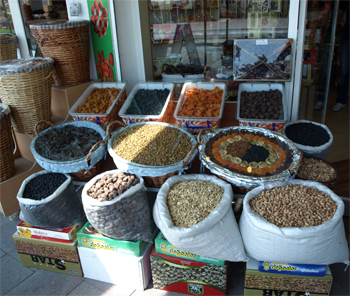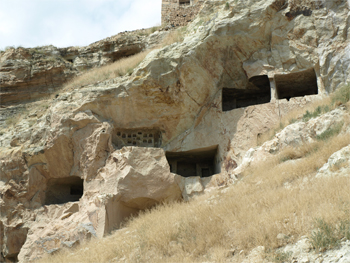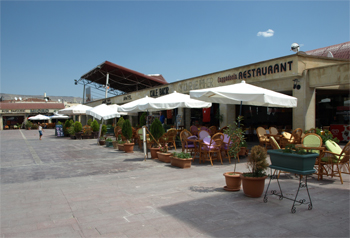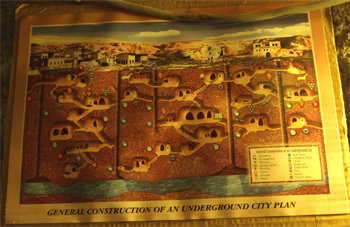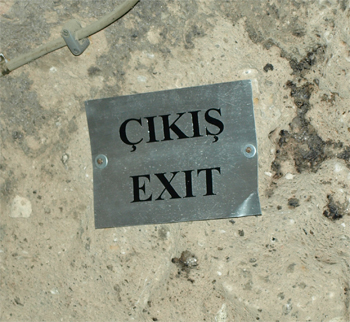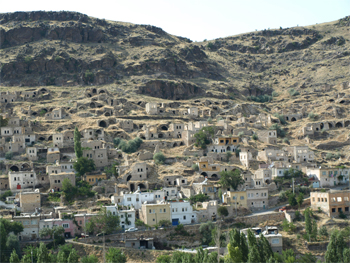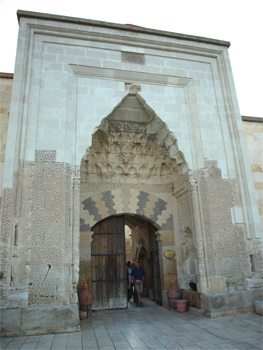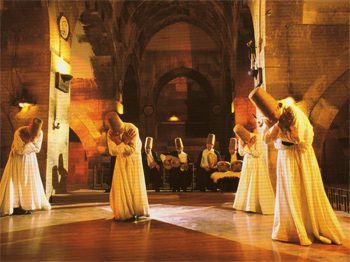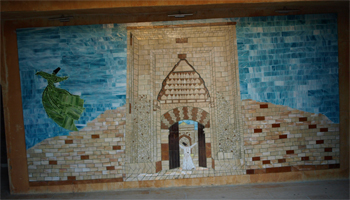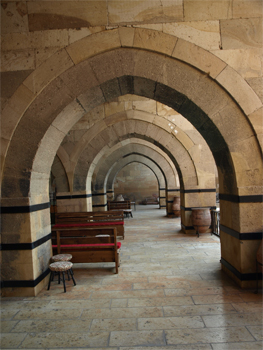Saturday - 8/29 – (continued) - Cappadocia
We drove on to Uchisar and checked into our hotel, the Ahbab Konagi, which is more like a B&B.
Ahbab Konagi Hotel
|
Ahbab Konagi Hotel from afar |
Blue eye protecting the hotel |
Our rustic door
|
Our rustic room |
Very nice veranda
|
View of the "fortress" from our veranda |
Street with vendors next to our hotel
|
Our rooms overlook the cave houses in the “fairy chimneys” that are all over this region. The fairy chimneys are formed of eroded volcanic tuff. A thin layer of harder basalt on the top prevents total erosion and forms these very curious structures.
There is a volcano in the distance that laid down a lot of ash, etc. in the area and over the eons wind and water have eroded it into unique formations. The rock is very soft and easily carved out to make rooms = cave houses. This is a very strange looking, but beautiful landscape.
|
Erciyes volcano - if you look real hard
|
At 5 PM (a little cooler?) we went for a hike amid these formations. At the top of the ridge were small sections of farmed areas and orchards. Pumpkins evidently grow well in this soil. They are grown mainly for their seeds, which are dried (often on people’s roofs), roasted and stored for later consumption. The small orchards grow peaches, cherries, etc.
|
|
|
|
|
Our trail/road descended into formations like the Painted Desert with pillars sticking up (the fairy chimneys). The road ended in the town of Goreme, which has many cave houses. Some of these structures are being turned into unique hotels. Two or three walls will be chiseled out of the soft rock and the rest is built of stone. This keeps the living space cool in the hot summers.
|
|
|
Flowers and vegetables are grown any where and in any kind of "pot"
|
|
Back at our hotel for a dinner of lentil soup (no two of these soups have tasted the same), a variety of starters (pickled veggies, grape leaf wrapped around rice, deep fried rolls of dough filled with goat cheese, cheese stuffed mushroom caps), eggplant stuffed with ground meat and sauce and rice, and four different Turkish pastries for dessert. It was wonderful in flavor and texture.
Sleep came easy tonight - however, just as in Istanbul, we were treated to the drums and loudspeaker. During Ramadan, about 2:30 AM a drummer walks around town beating a drum to wake people up so they can start cooking the last meal allowed to be eaten before sunrise. At 4:30 AM the loudspeakers on the minarets of the mosques blare out the “call to prayer.” The loudspeakers blare the “call to prayer” five times during the day. Men are expected to go to the mosque, after ceremonial washing, and pray five times a day. They may also kneel on a prayer rug where they work. People who are ill, have necessary jobs, are pregnant, etc. are excused from the fasting. Most of the Turks around town and in Istanbul take this very seriously.
Sunday - 8/30 - Cappadocia - Turkish Independence Day
This morning we had breakfast at the hotel. It included homemade yogurt, homemade bread, pastries, some fruit and cheese. A young man cooked us eggs as we wished and a woman sat on the floor and rolled dough into a large flat bread with a thin stick and cooked them on a heated drum.
We took the bus to what is called Love Valley and hiked to look at more rock formations and pigeon nests. It is called Love Valley because many of the formations have a phallic resemblance.
Love Valley |
Love Valley
|
Love Valley
|
Love Valley |
The holes in the pillars above are cut and hollowed out by farmers to make individual nests in which pigeons can roost. The face of the fairy chimney is often smoothed off to make it impossible for animals to enter and invade the pigeon nests. Each spring the farmer enters and scoops out the guano to use as fertilizer in his fields.
|
Flower and insect
|
Next stop - the Goreme Open Air Museum, which includes cave rooms of an ancient monastery, nunnery, and several Greek Churches complete with frescos on the walls and ceilings of the carved out rooms. Many of the frescos are destroyed because the Muslims threw stones at or scratched out the faces of the Christian saints, prophets and Jesus, believing that to “deface” them was to kill their spiritual beings.
|
Cave rooms
|
Cave rooms
|
Painted motifs |
Defaced frescos |
Defaced frescos
|
Frescos
|
Anyone for a ride? |
Lunch was in the town of Avanos at the Testi Kebabi Restaurant where their specialty is the testi kebabi so named from the shape of the pot the dish is cooked in. In spite of this novel dish, we had lentil soup with lemon and wonderful Ramadan pita bread with tomato salsa and feta cheese and Shepard’s salad (a mix of tomato, cucumber, onion, garlic, parsley and a little olive oil.
|
|
Testi Kebabi pot about to be opened
|
Wonderful stew hot from the pot |
Free time!
|
Late afternoon and a walking tour of Uchisar followed by a visit to a cave house
|
Minarete with loudspeakers
|
The Uchisar Pension |
We took off our shoes and walked through the cave kitchen - complete with shelves chiseled into the rock - and a dishwasher! In the main sitting room the floor slanted and was covered with fine Turkish carpets. The edges of the room had couches and pillows to sit on. Tapestries and carpets were hung on the walls and the ceiling was rock and low with one electric light bulb. In keeping with Turkish hospitality, the three-year old son gave us sanitizing cologne to clean our hands and then the mother served us Turkish apple tea in traditional glasses.
|
Cave home
|
Typical Turkish carpet |
Lace table doilie
|
|
We were struck by how similar some of the Turkish designs are to those found in the American Southwest.
|
Evening light of the eroded land forms |
|
"The Fortress" across from our hotel
|
People gathering on top of the fortress awaiting the end of the day's fasting |
Dinner was another gourmet delight. I am really enjoying all of the “starters.” Tonight we had a roasted onion with egg dish that was delicious. Our main course was a chicken, tomato, etc. stew roasted in a pottery pot. There was a sinful dessert buffet to end the meal.
|
|
Monday - 8/31 - Cappadocia
We started the day with a trip to the Pasha’s Vineyard to see more interesting fairy chimneys. The chimneys that have lost their caps to gravity are referred to as the “grandmothers” - they are just cones. The babies are the ones still connected to the hillside and need more erosion to stand alone. It was interesting that a segment of The Amazing Race was being filmed there.
Dinner was another gourmet meal. The French wife/owner tried to give us a sample of all kinds of traditional Turkish food. We had another eggplant grilled with tomato, etc, a cheese and phyllo pastry, hot potato salad with unusual herbs, bulgur rice, beef kabobs, BBQ chicken, and spicy meatballs. I liked everything and ate much more than I needed. Dessert was grapes and peaches in syrup. We will miss this place!
| Return to Top | Return to Itinerary | Return to Dreamcatcher Home Page |
